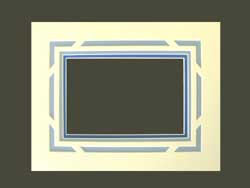- Custom Frames
- Closed Corner Frames
- Matting
- Mat Fillets
- Museum Mounting
- Vacuum Mounting
- Needlework
- Glass Products
- Oil Paintings
- Shrink Wrapping
- Ready-Made Frames
- Picture Lights
- Mirrors
Custom Frames
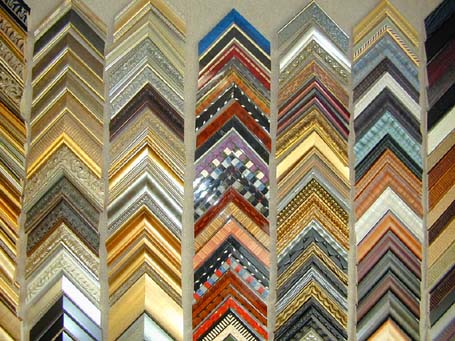 |
Frames can be fun, serious, dressy or casual based upon what the art or photo calls for and what is desired for the decor where the frame will hang. Here are a few photos of some of our best selling frames just as they appear on our sales wall. Since we carry over three thousand corner samples of frames to choose from, it is rarely difficult to find several possible frames for your artwork. It is our pleasure to help you to choose an assortment of frames, from which you might find the best frame for your art. Though our basic black mouldings are not shown here, we carry dozens of simple black frames for documents, or basic ones for paintings or posters, all at a great price. We have recently begun carrying several different locally produced lines of mouldings which are priced very low and which look very good. Most of these are wood frames in either black, cherry, mahoghany, walnut or blonde colors. We also have a limited assortment of gold and silver frames that are very inexpensive, many of them small profiles or simple shapes. Most of these frames are manufactured by the most prominent major moulding companies such as LaMarche, Nurre Caxton and AMPF. In the top photo, there are some basic gold and silver frames, but in the center of the photo are some inlaid frames that have a glossy finish. They are a bit on the expensive side, but are really nice frames for giving your decor a bit of splash and color. In the next row to the right are some decorative frames from the Roma Moulding Co. which have an old style ornate look. The next photo on the left shows some more of these inlaid and decorative styled frames. It's amazing what is available these days, the possibilities are nearly endless for coordinating decor to the color and styling of custom frames. In the next two photos are shown some imported frames from Italy. Most of these frames could have been made any time in the last hundred years, and many are copies of turn of the century frames from the late 1800's to early 1900's. They carry a distinction and interest that never seems to die. They still look as grand as when they were designed, and are elegant and suitable for expensive decor. From there, we have nearly a thousand frames in a mid price range which could frame nearly every art work imaginable. They come with many different kinds of washes or tints, which can help them to fit with the colors in your art. Whether silver, gold, pewter, or nearly anything in between, each frame has an appeal which suits it best for a certain kind of art. Because we realize that the sheer number of frames is a bit much for most people to look over, we take time to familiarize ourselves with each frame line so that we can know within a few minutes which from our assortment will be a close match to your artworks or decor. It is our pleasure to work closely with you to find the best frames for your application, or you can feel free to look over as many frames as you would like in order to make your selection. |
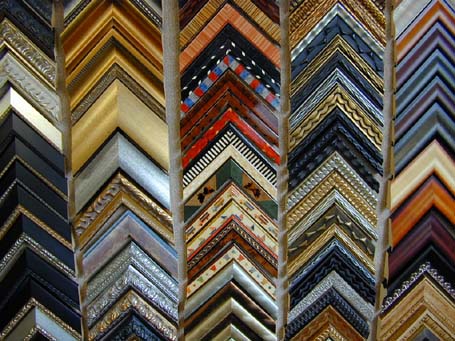 |
|
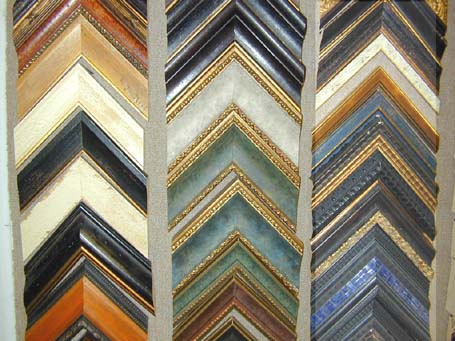 |
|
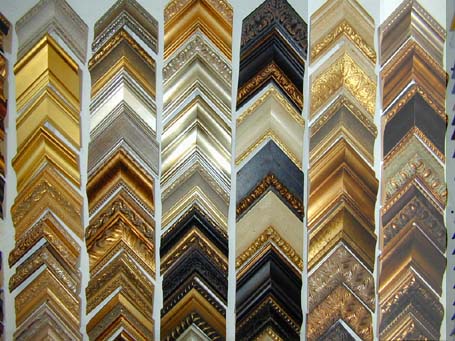 |
Closed Corner Frame
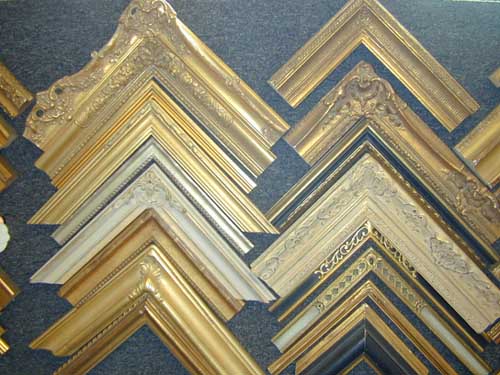 |
Closed corner frames are those that, like most picture frames, are made of wood, but in this case they are made to a certain size with the corner joints filled in and painted or leafed to cover the joint, thus making them appear solid. The frames pictured on the left are top of the line frames hand made by professionals who have been in the business for many years. This is quite different to what are called "ready-made frames" which are made by factories and have standardized sizes and finishes which cannot be changed or ordered to suit a particular application. We stock some ready made frames in various sizes such as 14"x18", 16"x20", 20"x24", etc, and can order many different profiles and colors. (We also have a section of frames made from stock mouldings in all sorts of sizes and profiles.) Many of these professionally hand made frames are considerably more expensive than regular frames, but provide a distinctive look and finished quality that makes them stand apart from any other frames available. These frames are not only made to order in any size, they can be made with an assortment of finishes and colors, for example, silver leaf with red or black undertones, gold leaf with a pink tone with a colored wash over it, or gold leaf with an appearance of being very old. The finishes can be adusted to suit the background, colors in the artwork, or to match your home decor such as furniture or draperies. You can bring in swatches of fabric, paper or colors from a paint store and we will order your frames to match them. This service is always available but keep in mind that it can take 4 to 6 weeks to get in a special order frame. A few of these companies are local, but most are in large cities such as New York, Los Angeles, or other cities in California. We are proud to offer these frames at very competitive prices. Many times it is the designers who order these frames to fit the decor of the houses they are designing, and choices are made concerning finishes and corner styles to reflect the theme of the decor. Since we have been working with designers for over 15 years, we have gotten a good idea of what is appropriate for various settings, and feel confident in helping our customers select these for their original oil paintings for home or office decor. There are a great many more of these frames available than what we have shown here. We have many catalogues that show other designs, profiles and finishes, so if you would like us to help you with this sort of framing, please feel free to come in and let us show you both the frames we have samples of and any catalogue which might have a particular frame not shown here. |
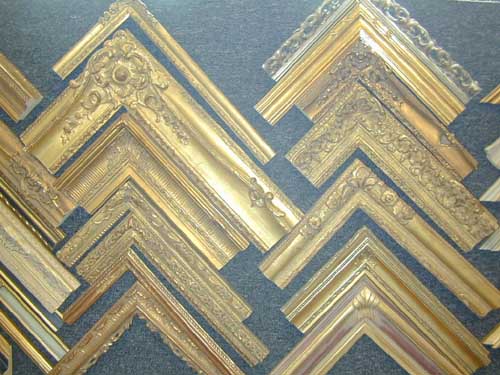 |
|
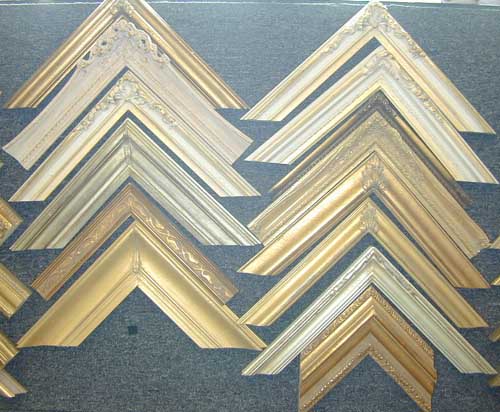 |
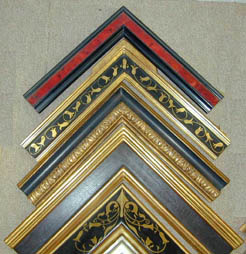 |
Here on the left are a few examples of a different sort of closed corner frame. These are not as expensive as a hand made frame, but still have a closed corner. This set on the left show some of the styles with a panel of darker wood tone or black. These frames are available in any size but are only available in the finishes and styles you see pictured. (If you have any difficulty in telling which moulding is which, look over at the edges so that you can see where one moulding stops and another begins). |
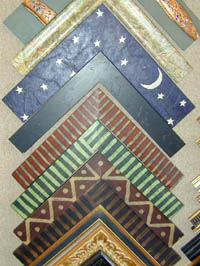 |
This next group is considerably different to the first ones. They are made by a different company, and are more of a folk style than the professional and tailored look of the ones above. Yet they are very decorative and will look great on the right artworks. They can also make great mirror frames, in fact, we can have a mirror made for virtually any frame! |
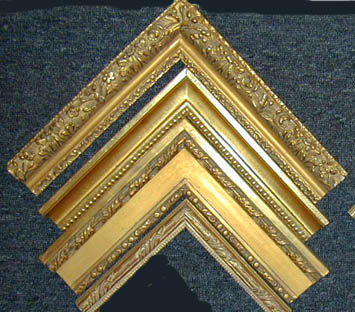 |
Here are a few more examples of closed corner frames, these are antique gold finishes and turn of the 20th century styles which are made primarily for classic old paintings and for rooms with traditionally styled decor. They add an elegance and charm. |
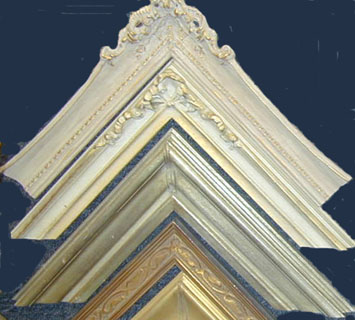 |
In this last set the top two are made by a California company and have on them what is called a "bone finish" with gold highlights. These are nice to use on women's and children's portraits and for mirrors. |
Matting
The main purpose of a mat is to serve as a buffer area allowing the art work to blend in or stand out in the immediate surroundings of the place in which it is being displayed. In order to best provide this buffer space, we recommend that the mat width should always be noticeably wider than the frame being used to give the artwork adequate viewing space. Whether an off white top mat is used or a strong color, the most important point is that the mat is there to present the work and tie it in with the rest of the decor, and should not distract your attention from the art. Another point is that the matting should not be brighter than the piece or attention will be drawn to the mat instead of the art. The same could be said for textured mats, which should be used to flatter or set the artwork off, but not to draw attention to itself.
The mat design shown on the right incorporates both a triple mat and an open V-groove showing the second mat color through the top mat. This design adds accent to this secondary color, while allowing the very bottom dark blue color to provide another less strong accent. A "V-groove" is a cut made into the mat from the top to create a cut line in the mat, or in the case of an "open V-groove", to show the color under the top mat in order to provide more color accent.
The mats that we use for most all artworks are actually not made of paper, but are made of cotton! The cotton "rag" mats are called archival mats becauses they are made of cotton and carry no natural acidity. Paper mats can easily be spotted because their bevels turn brown due to their natural acidity. If you look edge-on at the matting you have on your pictures, you can readily tell if they are paper because the bevel edge will have turned brown. If your mats are 'rag' mats made of cotton, the edge will be pure white and will not brown over time. Acidity in matboards is what gives them a brown bevel and over time causes damage to your artworks which cannot be later repaired. We invite you to bring in any artworks that you think might have paper mats. We will advise you of the best replacements if they are needed and will also advise you about the mounting of your artworks to help save them from acidification.
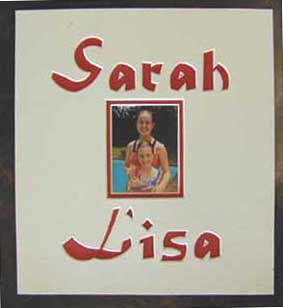 |
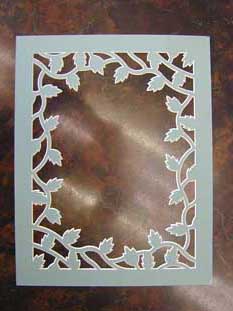 |
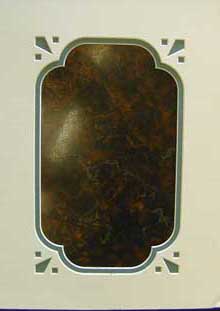 |
The mats shown here demonstrate what we can do with lettering, and this can be done with any of about two dozen different fonts. The mat in the middle could be used with a poem about autumn leaves or something about wine, for instance. The one on the right above could have an old style family photo in it.
What ever your matting needs are, we will try our best to come up with the right solution for your framing requirements.
We can also have name plates made showing whatever information you would like, such as dates, events, or other special family memories which would go along with photos or other memorabilia which might suit your needs. Please don't hesitate to ask us to order a plate for your picture, they are available in gold, silver, and black and can be made with many different fonts and engraving styles. We can cut an opening in the mat for the plate, or it can be placed right on the mat in most cases.
Mat Fillets
Mat Fillets are small prefinished strips of wood or polymer that are fitted inside of a mat opening and are used to frame the opening in order to further highlight the artwork. Many times we use mat fillets with florals or bird prints so that the colors or foliage stand out. Fillets are also used to enhance matting, with the fillet going between layers of mat. This can help a large mat by breaking up the mat into two sections.
A mat fillet is like a smaller frame that fits into a double or triple mat which can add elegance and style to framing anything from prints to documents or original artworks. It provides a sort of border or way of highlighting art, and is made from the same materials as mouldings, usually wood with a black, cherry, or walnut stain, or they can be leafed in gold, silver or pewter. We carry a wide assortment of different fillets, which can be plain or ornately styled. Because fillets are made of wood, they carry a natural acidity which can, if not properly isolated from the art, cause some discoloration. At the Artery, we take pride in completely isolating the fillet from the art so that no damage can occur through this kind of contact. We do this by using pieces of cotton rag material between the fillet and the art, so that the fillet never comes into contact with the art.
Below are some of our fillets, which come in many colors, sizes, and profiles. As with all aspects of framing, it is our pleasure to assist you in choosing the right materials for your artworks.
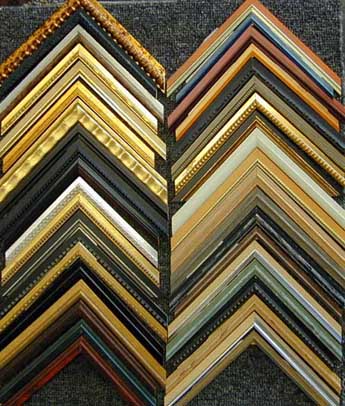 |
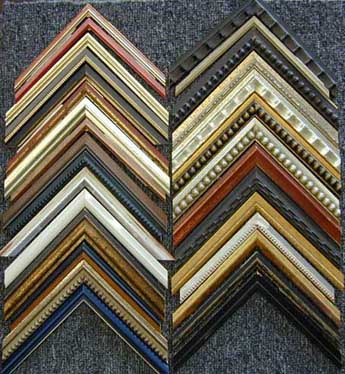 |
Museum Mounting
What is museum mounting, and why is it important?
Artwork such as limited edition prints and other fine pieces should never be glued to a board or subjected to heat. Instead, they can be mounted using a number of different techniques and materials so that no heat, glue or other substances come into contact with the artwork, potentially devalueing it. In most applications, art works are hinged to cotton rag matting, just like a stamp collector uses in albums. This is called MUSEUM MOUNTING. When museum mounting, a sheet of barrier paper, also made of cotton rag, is used along with foam core and the matboard. These three components ensure a non-acidic and stable environment for virtually any artwork. For the most fragile of articles however, wheat paste hinges or rice paper are used, instead of the regular linen hinges, and archival foam core might also be used.
In addition, in some cases we use archival corners, a product made of plastic triangular pieces with adhesive on the back to stick to the cotton rag board, and open on the front, so that the art can be placed into the corner using no adhesive, glue or hinge. The one drawback to using these corners is that the artwork is not able to hang freely in the framing as when using hinges, and this can cause some rippling over time due to expansion and contraction of the art due to changes in temperature and humidity. The advantage to using hinges is that the art can hang freely in the framing because it is only hinged at the top. This is considered the best for most artworks.
We use many different materials to mount art objects. In museum mounting, what is mostly used is filmoplast, which is a special tape-like product which is made specifically for mounting art objects. It has it's own adhesive qualities without wetting, and does a great job. We have re-mounted pieces to different matting and have found that even after five or ten years, the filmoplast holds with no breaks. Another product we have used over the years for museum mounting is linen tape, which is tape actually made of linen and has one side that has glue on it so that when moistened it will stick to anything made of paper. We often use this in conjunction with filmoplast, but only very small pieces with just the barest amount of water to activate the adhesive. We feel that when two different materials are used together, the mounting will hold most securely over time.
Our mounting processes, whether we use mounting adhesives for posters or if we use hinges for prints or other art, never use heat. This is quite different from "dry mounting", which many customers request. However, dry mounting involves high temperatures in a heat press, which can damage paper. We have seen many prints and posters brought in by customers who have had framing done using "dry mounting" and have seen that the paper is damaged, showing cracks and discoloration. We have therefore decided not to use heat when mounting, and have found that our mounting holds up very well over time without the use of heat.
Vacuum Mounting
What is vacuum mounting and what is it used for?
Have you ever had a poster framed only to have it ripple and bend? This is because the poster was not vacuum mounted, which would have kept the poster flat. Vacuum mounting is done using foam core or a thick board like a matboard on which to mount the piece, and an acid free adhesive made specially for mounting posters and other articles. The piece is put in a vacuum press long enough for the adhesive to set, usually several minutes, after which it is placed in a special section where it can set up (usually overnight) with a very slight convex bow. This insures a smooth and complete contact with the surface of the glass when the poster is fit into the frame. The vacuum mounting process is always used when we prepare a poster that is not to get a frame.
For those posters that we want to hang more inexpensively than would be possible with a regular frame, we can mount it as above but then glue on a piece of wood that measures 1 inch x 2 inches on the back, with the wire already in place to hang it with. This is called aptly, a "mount and brace."
We recommend vacuum mounting for most all posters, documents, and certificates because without proper mounting, the object will ripple and distort in the frame from the gradual retention of moisture by the paper fibers. We would like to distinguish this type of mounting from a process called "dry mounting", which uses a heated vacuum press and sheets of adhesive treated paper. The artwork is placed in the heated press and the adhesive is transferred to the artwork thus securing it to the foam core. This process is very similar to regular vacuum mounting, but we feel that the use of heat in mounting is damaging to artwork, so we do not recommend nor use this method. We find that the regular mounting process has all the positive aspects of "dry mounting" without damaging the artwork from the heat used in "dry mounting".
At the Artery, we have built one of the largest vacuum mounting presses available anywhere, and can fit a 4' x 8' sheet of plywood inside of the press with room around the edges. Most vacuum presses are at most six feet on the long side, and cannot mount the largest pictures.
Needlework
Many of our customers make needleworks that they spend a great many hours on and want to have presented in the best way possible. We use great care in mounting a needlework lining up row by row, so that the work is straight and centered in the frame. To mount the needlework, we start by mitre cutting and building a banak lattice bar, which is a kind of wood somewhat stronger than balsa wood, but also still somewhat soft. To protect the fabric and stitching from the natural acidity of the wood, we place a sheet of cotton rag over the lattice bar. Then we lay the work over the cotton rag sheet and staple it to the side of the bar. This procedure enables us to line up the stitching precisely so that it comes out evenly.
The one and only time we ever vary from this style of mounting a needlework is when it is very old and the work might tear from stretching it. In this case we might sew it on with monofilament very carefully in many places so that it stays in place when it goes into a frame, or we might very lightly spray the back with adhesive made for fabric to hold it in place (for pieces where the customer specifically says that our usual special care is not necessary).
We take pride in framing needleworks with special care because they take so much time and effort to make.
Glass Products
Glass greatly enhances the appearance of posters, prints, or art objects. The glass we buy of itself filters out about 30% of the UV rays which are becoming more predominant in our sunlight. For most applications, we feel that this regular glass product is sufficient for framing. Yet, in order to protect your valuable prints, we carry a full line of UV protective glass, which filters out 97% of the UV. Yet even when using this product, at no time do we recommend that any artwork be hung in a place where it will be in the direct sunlight, for we feel that no product is able to protect adequately against full sunlight.
We can obtain very large pieces of glass for the really big pictures, but for safety reasons we recommend the use of plexi-glas, or what is now more often called acrylite. Although acrylite is somewhat more expensive than regular glass, it is just as transparent and attractive for framing. It comes in different thicknesses, and can be obtained with the UV screening capabilities.
Below is a handy reference for the different types of glass we carry. There are also different shapes of glass that are available, like dome glass, or convex glass. These products usually fit into antique frames.
ent 8NON GLARE GLASS
There are also several glass products which make the glass much less reflective so that glare on the surface is minimized. 'Non-glare' is a good, inexpensive choice for this kind of product. It does tend to make the picture a bit less clear, but in a place where there are many light sources that reflect off of the glass, it can really be a good choice.DENGLAS
Denglas is another of the antireflective glass products rather widely used for today's framing because it offers amazing transparent qualities. This glass product can also cost four times what regular glass costs, but can be invaluable in presenting an artwork where the glass protects the art, but cannot readily be seen. The denglas company has created yet a new product called Waterwhite Denglas which is virtually transparent when on artworks. Not only does it virtually eliminate glare, but you would almost swear there is no glass at all when looking at something framed with it. Regular Denglas has a greenish reflection when viewed obliquely, while the waterwhite has a very light bluish green reflection.MUSEUM GLASS
Museum glass is a product made which both filters out UV rays and provides a superior anti glare appearance which is a step above even Denglas. This is one of the best glass products we carry, and though it is very expensive it is second to none in appearance. The relative value of the artwork's clarity of presentation is the most important factor to consider when trying to decide whether or not to use an anti-reflective glass product. With the UV glass product the issue is more straightforward; that if the artwork is valuable and you really want to preserve it, then UV screening glass is essential. The use of anti-reflective glass, however is a much more subjective question, and should be based upon the value of the artwork, and how well it can be viewed in the environment where it is presented. When there is an artwork that is so good that you want to really show it off or if there is a chandelier or other multi-pointed light source, then perhaps the anti-reflective glass is the best option.AR GLASS
AR glass (anti-reflective) is another product on the market which offers anti-reflective qualities. This product has a coating of material which absorbs or scatters most of the light reflecting from it. Most of the light goes through the glass in both directions so that the artwork is illuminated more, and can be seen with amazing clarity. This glass product is about the same as denglas in cost. Most of the difference between it and denglas is that it is made by a different manufacturer with slightly different materials and baked at a higher temperature.
Oil Paintings on Canvas
Paintings on canvas can be done with various media, but usually are either oil paint or acrylic paint. Thickening agents such as matte medium or emulsions can be added to the paint to give it differing looks and qualities of transparency or opacity. Our main concerns with paintings are if they are stretched correctly on stretcher bars that are in square, or are they stretched onto bars that have the shape of a parallelogram. Most of the inexpensive brands of stretcher bars have the parallelogram shape when the painting is stretched, so that it will not fit a frame that is in square. To compound the problem, when the painting is restretched onto bars that are in square, diagonal folds of canvas appear and the painting must be carefully stretched even tighter to eliminate those folds. Artists should check their bars with a T-square or other object that has a right angle on it, and cut small struts that would be applied to the corners of the bars to hold them in square until the painting is stretched. Much later expense could be avoided. We do not think it harms a painting to be stretched this extra factor, yet it does cost extra money to do so, since it is a very labor intensive job.
Our other main concern with paintings on canvas is the depth or thickness of the bar. If it is very thick it won't fit many of the frames we carry in stock. We do have a large assortment of frames that have a greater depth, the only point here is that fewer frames will be available if the bars are thick. We carry a specially milled fir stock for this purpose, and can build bars of nearly any size with either the milled 1X2 or the milled 2X2. In building the bars, corner braces are used as well as a center strut that is V-cut into the bar to make them strong enough so that they don't change shape as the canvas is stretched. Without the center strut on a large bar, the tendency would be for the bar to take on an hour-glass shape, thus making the center of the bar less wide than the corners. This can also make the painting lose a lot of size when it is restretched for framing, especially in the corners.
Many artworks on canvas such as oil paintings rarely use glass with their framing because of the tendency to promote microbial growth between the relatively non-porous glass surface and the non-porous surface of the paint. Yet in the case of a very small oil painting, this rule gets broken because we will often mat them and put them in a frame with glass. With the addition of the matting, there is an air space between the oil paint and the glass, and there is the cotton rag material of the matting to absorb any excess moisture, thus ensuring that having the glass on the oil painting does not cause harm. With a very small painting you may want to use image perfect glass or denglas since with a small size the cost of the glass is not as great.
We have recently begun to carry oil paintings and many other fine art items. Our intention is to continue to widen our selection of paintings to include a range of subjects and styles. You can see samples of our current collection below. If you would like to see a larger selection, you can sign up to come in and view a much wider range of paintings on a certain day which we will alert you for a week or two in advance. In addition to seeing a wider range of paintings, we are offering an additional ten percent discount for coming in!!
One of the sources of our oil paintings is a company from Atlanta which has several semi trucks full of paintings. Every six weeks or so they come around to Greensboro and stop by to show us their latest inventory. Most of the paintings have frames on them but frames can be switched or paintings can be purchased without a frame. If you would like another frame on the painting you like, they can be switched on the spot, which is another advantage to coming when the truck is here. In any case, all paintings are already stretched onto wood bars and are ready for framing if they are not already in frames.
If you want to buy a painting, you simply write a check to the Artery for the amount shown on the paintings, less your ten percent discount. The delivery truck will contain a wide selection of landscapes in different sizes, florals, still lifes, animals of various types, different old style street scenes and many other types as well. If you like oil paintings, this is a great deal that shouldn't be passed up! All you have to do is give us a call at (336) 274-9814 and ask let us know when you might be able to stop in for an hour or two and we can try to set it up for you.
Shrink Wrapping
Some projects only need a thin film of plastic over them for presentation or for preservation, and for this we have a product called shrink wrap. We can shrink wrap any poster or art that you may want to preserve up to about 34" on the short side(width or height), and as long as needed on the long side. We sometimes have used shrink wrap film instead of glass, particularly in children's rooms or in an institutional setting such as a store display or cafeteria. (Plexi-glas is also widely used in these special applications.) Shrink wrapping is very inexpensive and goes a long way in protecting artworks that you don't want to frame within the shortrun. It will protect against moisture and contact with oxygen, both which tend to degrade paper products in the long run. (framing also protects art by sealing it in ragboard and glass)
Ready-Made Frames
Here are some of our ready made frames, which we have made from our stock in all sorts of sizes from the standard sizes 4x6, 8x10, 11x14 and etc... plus an assortment of sizes in between. We have found that customers bring in all sizes of things to frame, so we just tried to keep the proportions accordingly and not make them squares. If you come in you may see different frames to the ones pictured because we sell so many of them, but you can always print this page and bring it in to see if we still have one of the frames pictured.
There are quite a few styles represented, from traditional high at the back low at the lip, to contemporary high at the lip and low at the back, plus document frames and frames for needleworks and small photos. If you would like us to make some ready made frames from our old stocks, please let us know if you would like shiny or muted gold, silver, pewter, or perhaps black or wood tone frames, and we will be glad to look over our supplies to see if we can fill your order. We ask that you give us extra time for these.
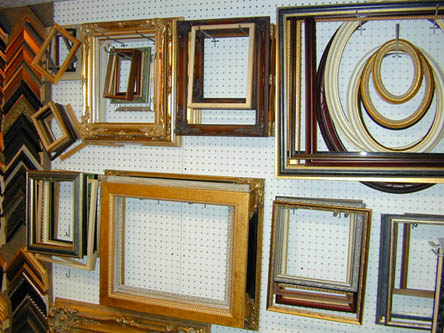 |
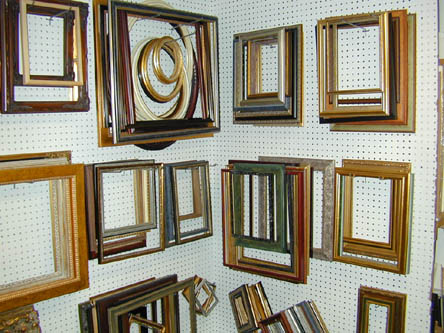 |
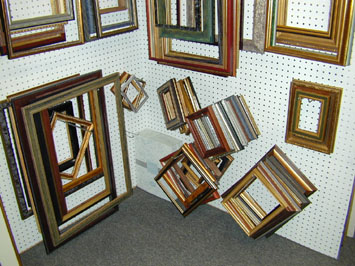 |
|
Picture Lights
Picture lights can really help to illuminate a painting by providing a direct source of light. We carry mostly Troy picture lights in 5", 9", 13", 18", and 24" with one, two or four 25 watt or 40 watt bulbs depending on the size. They come in antique gold or bronze and have a regular plug on them for electricity with a six foot cord.
We do carry lights without a cord which operate on battery power, but as yet we have been unsatisfied with these and hope that LED lighting will quickly become available. It requires very little power and has a very bright light, but as yet the technology is not quite perfected and they are not available yet.
Here are a few photos of picture lights, they have a bar on the back of them that is not shown in these photos, which is used to secure the light to the painting. In the second photo, you can see the paper wrapper on the bulbs, so for this light there are two bulbs. The finish shown is the "antique gold", and is by far our best selling light.
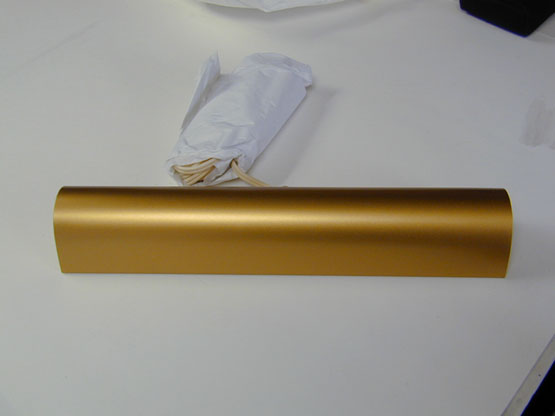 |
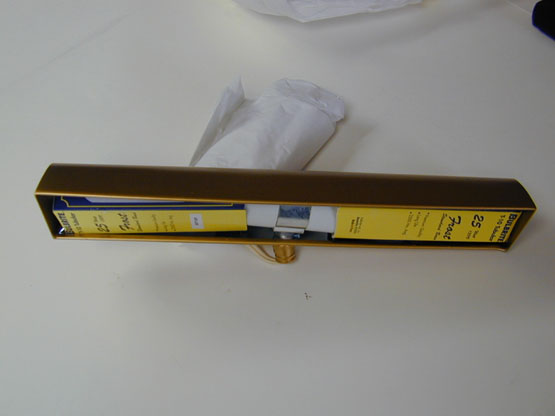 |
Yes, we have mirrors!
A mirror can add depth to your favorite room, enhancing the feeling of spaciousness. We can have mirrors made in virtually any size and with any frame (well, nearly any!), with or without bevels, and with a goldish hue as well as the usual mirror color. These could be used in different settings according to the place you would like to put the mirror and what your other decor is like. The best way to order a mirror is to come in and select a frame for your decor, give us the size you want the framed mirror to be, and we will do the rest! There is usually a ten day turnaround for mirrors, but we have done them in as little as two days when the need is there.


